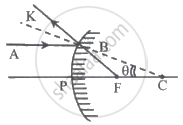Advertisements
Advertisements
Question
What is the near point focusing?
Solution
The image is formed at a near point, i.e. 25 cm for the normal eye. This distance is also called as least distance D of distinct vision. In this position, the eye feels comfortable but there is little strain on the eye.
APPEARS IN
RELATED QUESTIONS
Answer the following question in detail.
Define and describe the magnifying power of an optical instrument.
Answer the following question in detail.
Obtain the expressions for magnifying power and the length of an astronomical telescope under normal adjustments.
Answer the following question in detail.
What is the limitation in increasing the magnifying powers of the astronomical telescope?
Discuss about simple microscope and obtain the equations for magnification for near point focusing and normal focusing.
What are the advantages and disadvantages of using a reflecting telescope?
What is the remedy of myopia?
What is hypermetropia?
What is the remedy of hypermetropia?
What is astigmatism? What is its remedy?
Mention different parts of the spectrometer.
Explain the experimental determination of the material of the prism using a spectrometer.
When a convex lens of 12.5 cm focal length is used as a magnifying glass, normal eye can see an object clearly at a distance of 25 cm. The magnifying power of the instrument is ____________.
If astronomical telescope of length 1.53 m has magnifying power of magnitude 50, the values of fo and fe are ____________.
A simple microscope is used to see the object first in blue light and then in red light. Due to the change from blue to red light, what is the effect on its magnifying power?
An object viewed from a near point distance of 25 cm, using a microscopic lens with magnification '6', gives an unresolved image. A resolved image is observed at infinite distance with a total magnification double the earlier using an eyepiece along with the given lens and a tube of length 0.6 m, if the focal length of the eyepiece is equal to ______ cm.
The image formed by an objective of a compound microscope is ______.
In the adjoining figure, AB represents the incident ray, and BK is the reflected ray. If angle BCF = θ, then ∠BFP is given by ______.

A camera objective has an aperture diameter of d. If the aperture is reduced to diameter d/2, the exposure time under identical conditions of light should be made ______.
